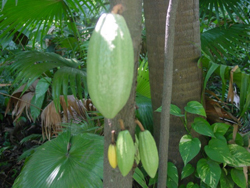
 |
| Image of Theobroma cacao plant. |
Abstract
Deforestation has been a big problem in the Dominican Republic as previously forested areas are cleared to make way for plantations, grazing pastures and tourist resorts. A sustainable initiative in organic farming with plants like cocoa has provided new opportunities for maintaining a tree cover while providing small-scale farmers with a better income. The purpose of this experiment was to examine the relationships between the highly invasive small fire ant – Wasmannia auropunctata and the mealybugs (hemipterans in the family Pseudococcidae) that feed on the phloem of plants, particularly the Thebroma cacao (commonly known as Cocoa)plant. In this experiment, I identified 40 incipient T. cacao shoots, which hosted a number of ants and mealybugs, and tested what happens to the latter, once the ants were removed. I attempted to keep the ants from entering half of the replicates by physically removing the initial population and then applying a sticky resin to the base of the plant. This resin served as a barrier and prevented ants and other crawling insects from climbing the plant stem. The plant growth was charted by measuring the leaf dimensions and plant height- once at the beginning of the experimental period and again at the end. I found that the number of mealybugs in the plant declined immediately after ants were removed, possibly indicating that these hemipterans rely on the ants for protection. Meanwhile, the plants with few or no mealybugs seemed to grow slower than plants with a lot of mealybugs. This observation went against my expectations, and was probably because the plants derived their nutrition from large trees and the phloem-extraction by the mealybugs had little effect. However, the leaves of the plants showed the opposite result. In the control plants, the leaf growth was slower compared to plants with hardly any mealybugs or hemipterans. Additionally, I found that the difference was more defined as one went down the stem from the terminal leaf. This trend in leaf growth seems to indicate that the mealybugs’ extraction of phloem sap reduces the rate of leaf regeneration and growth in the plant, but in a non-uniform way. Due to the short duration of this study, some of the results were not statistically significant but they serve as a basis for designing future research efforts looking at mealybugs as a pest in cacao and other tropical crops.
Go to Science Research Projects.
Go to Learning Objectives of Research Project.
Return to E&ESJ home page.
Last updated: 8 January 2001, KAK.